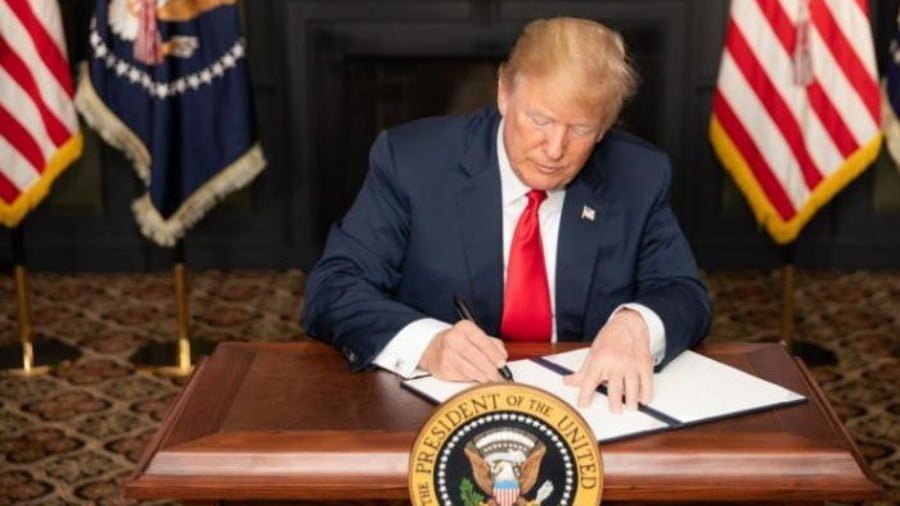The Military Industrial State Confronts Russia and China
The swaggering arrogance of Washington’s Military-Industrial Complex never ceases to intrigue the rest of the world, much of which shrugs collective shoulders but has to acknowledge that the swaggering reflects the US National Defence Strategy which informs us that the military is going to concentrate on confronting Russia and China.
One of the loudest voices in the confrontation chorus is that of the Commander of US Naval Forces in Europe, Admiral James Foggo III, who knows that the noisier he is, the more money will be allocated by government to acquire more and more ships. And he is very good at being noisy. In 2016 he wrote a particularly bellicose piece for the US Naval Institute, titled ‘The Fourth Battle of the Atlantic’ in which he castigated Russia for not acknowledging that the United States is supreme. He declared that “the new Russian national security-strategy depicts the United States and NATO as threats to Russian security and accuses us of applying ‘political, economic, military, and information-related pressure’ on Russia.”
He is absolutely right about the US-NATO threat, because it has been growing for almost twenty years. As I’ve written before, after the Warsaw Pact disbanded in March 1991, NATO, although deprived of any reason to continue in existence, managed to keep going, and in 1999 added Poland, the Czech Republic and Hungary to its 16 members. As the BBC noted, these countries became “the first former Soviet bloc states to join Nato, taking the alliance’s borders some 400 miles towards Russia.”
With good reason Moscow wondered what on earth the US-NATO military cabal might be planning.
The New York Times recorded that the 1999 expansion was “opening a new path for the military alliance” and expressed delight that the ceremony took place in the town of Independence, Missouri, where “the emotional Secretary of State Madeleine K Albright watched the three foreign ministers sign the documents of accession, signed them herself, then held them aloft like victory trophies.” Ms Albright was born Marie Korbelová in Prague and “made no secret today of her joy as her homeland and the two other nations joined the alliance.” But neither she nor anyone else is on record as explaining what “new path” would be taken by NATO.
NATO continued to expand around Russia’s borders, inviting Bulgaria, Estonia, Latvia, Lithuania, Romania, Slovakia and Slovenia to join in 2002, which they did two years later.
There is little wonder that Russia is apprehensive about NATO’s intentions, as the muscle-flexing coalition lurches ever more eagerly towards conflict.
Further, the US itself has hundreds of military bases, spread all round the world. As noted by Nick Turse “Officially, the Department of Defense maintains 4,775 “sites,” spread across all 50 states, eight US territories, and 45 foreign countries. A total of 514 of these outposts are located overseas, according to the Pentagon’s worldwide property portfolio… But the most recent version of that portfolio, issued in early 2018 and known as the Base Structure Report, doesn’t include any mention of al-Tanf [the US Special Forces base in Syria] or for that matter, any other base in Syria. Or Iraq. Or Afghanistan. Or Niger. Or Tunisia. Or Cameroon. Or Somalia. Or any number of locales where such military outposts are known to exist and even, unlike in Syria, to be expanding.”
Yet Admiral Foggo insists that “an enduring objective of Russian foreign policy today is to challenge NATO and elevate Russia on the European stage once again.” Well, certainly Russia wants to be on the European stage, and it must be pointed out that it’s closer to that stage than is the US. It wants to trade with Europe — as is appreciated by the main European powers, Germany and France — and would be crazy to take action that would work against this mutually beneficial cooperation.
Unfortunately, Poland and the Baltic States of Estonia, Latvia and Lithuania are verging on the paranoid about Russia’s supposed “threat” to them — but there has been no indication of any sort by Moscow that Russia has any intention of moving against them in any way. Trade with these countries is important, too, but this hasn’t stopped the paranoid quartet from indulging in a vastly expensive operation to “decouple power grids from Russia” in spite of the fact that “Russia, on which the Baltic states currently rely to balance their power flows, has never cut power or threatened to do so.”
This is all part and pattern of the anti-Russia obsession that is mounting in much of the West, and plays into the hands of such as Admiral Foggo who now, some three months after an incident in the Kerch Strait last November, announced it “irritates me to no end” that Russia detained and charged 24 Ukrainian sailors who were involved in the illegal passage of some Ukrainian vessels. Foggo’s fury lies in his belief that “They are uniformed Ukrainian sailors and officers and chiefs. They’re not criminals, and they are being charged under a criminal code.”
None of his pronouncements make sense, but on February 19 Foggo despatched the guided-missile destroyer Donald Cook to the Black Sea where it is to conduct “maritime security operations and enhance regional maritime stability, combined readiness and naval capability with our NATO allies and partners in the region.” The provocative sortie by the Donald Cook will achieve absolutely nothing other than the heightening of tension between the US and Russia, which, unfortunately, is the object of the exercise.
Which brings us to the other region where the US Navy fandangos for freedom, the South China Sea.
On that side of the world the US is represented militarily by Admiral Philip S Davidson, the Commander US Indo-Pacific Command, who doesn’t like China. On February 12 he warned the US Senate Armed Services Committee that China’s “first aircraft carrier group, centered around its refurbished Soviet-built carrier, reached initial operational capability in mid-2018” and its “first domestically-built aircraft carrier has completed four sets of sea trials since May 2018 and will likely join the PLA Navy fleet in 2019.” This is very interesting, but what he doesn’t say is that the United States has eleven fully operational carrier strike groups, one of which, headed by the carrier John C Stennis, as recorded by Stratfor, “is underway in the US 7th Fleet area of operations in support of naval operations to ensure maritime stability and security in the Central Region.” It is, as noted by the US Naval Institute “in the South China Sea” where it will contribute to tension by sailing through waters averred by China to be its own. Admiral Davidson announced that China was not abiding by the UN Convention on the Law of the Sea and naturally failed to note any amusing irony in the fact that the United States has not ratified the Convention. But in any event, in the eyes of Washington’s Military Industrial State, UN rules are valuable only when they coincide with US policy.
On January 7 the US Pacific Fleet announced that the USS McCampbell, a guided missile destroyer, had carried out a “freedom of navigation” operation, sailing within 12 nautical miles of China’s Paracel Islands “to challenge excessive maritime claims.” Then on February 11 they were at it again, with CNN reporting a 7th Fleet announcement that the guided-missile destroyers USS Spruance and USS Preble had sailed within 12 nautical miles of the Spratly Islands “to challenge excessive maritime claims and preserve access to the waterways as governed by international law.”
Washington has woven a pattern of military confrontation, from the Baltic and the Kerch Strait to the South China Sea, that is intended to antagonise Russia and China. It may be claimed that provocational manoeuvres in the air, at sea and on land are undertaken with the aim of altering Chinese and Russian policies, but the only consequence of these juvenile jamborees is to heighten tension, increase distrust, and pave the way to war. That’s the path envisaged by the New York Times in 1999, and it’s being followed faithfully.
One can only hope that Trump might see the beckoning light of cooperation and prosperity rather than following the path of confrontation, but he seems to be at the mercy of the Military Industrial State. If so, there can only be grave trouble ahead.
By Brian Cloughley
Source: Strategic Culture







